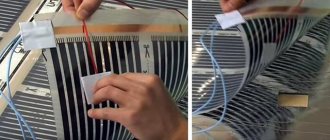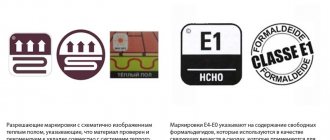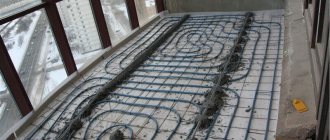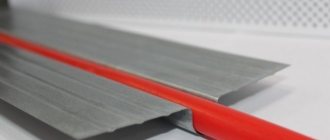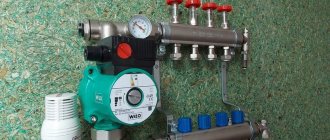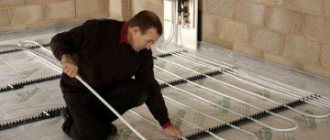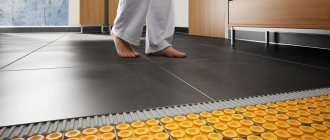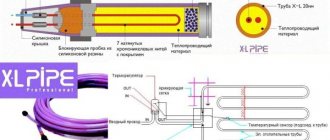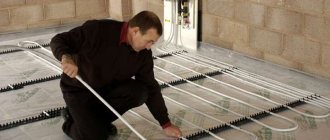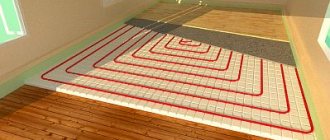Advantages and disadvantages
Choosing the right flooring is not easy. You won’t be able to limit yourself to just a harmonious shade for the overall interior. It is necessary to take into account the quality of materials, their strength, wear resistance, and also take care of the arrangement of the floor, especially when it is planned to use tiles as a finishing touch.
Heated floors will bring additional comfort and coziness. Many people like to walk barefoot at home, but this is unpleasant on cold tiles or linoleum and can be harmful to health. Over time, joint diseases may begin to develop due to constant hypothermia. A heating system is a must with tiles, especially in the kitchen.
Advantages
The advantages of a heated floor are not only comfort, but also that it is a full-fledged heating system in the off-season, when it has already become cold outside and the central heating has not yet been turned on. The heated air rises to the top, warming the entire room well.
Advantages of the heating system
Classic heating is effective, but at its core it can be called a point source of heat, since the room is heated unevenly. At the same time, the cold actively penetrates through doors, windows, and walls facing outside. This heating method does not always maintain the same temperature, so recently heated floors have been in great demand. Its advantages are:
- natural body heating – from bottom to top;
- insulation of external walls, areas near windows;
- exclusion of drafts;
- possibility of temperature adjustment.
A floor insulated in this way becomes not just a luxury, but a necessary condition for comfort.
Even when the central heating is turned off, the power of the surface is enough to avoid any discomfort. This is especially true in apartments and houses where there are children.
Flaws
Design disadvantages include:
- dismantling the existing coating and reinstallation;
- the temperature in the cabinet compartments that are located close to the floor will be higher, so you need to reconsider the principle of storing food that spoils due to elevated temperatures;
- the cost of equipment and installation of the system is impressive;
- Electricity costs increase by approximately 1000 - 2000 rubles. per month.
Operation of the floor heating regulator
The thermostat is equipment that regulates the temperature of water floors according to specified parameters. Along with it, devices are used that control the level of heating of the floor surface and air in the room. The heat supply regulator is a servo drive.
The thermostat operates like this: it checks the temperature in the room, compares it with the set value, then gives a command to the system to turn it on and off. They act this way only indirectly. The thermostat tells the servo drive, while it turns the faucet, regulating the speed of water flow. In a water device, this reaction may be slow: it is associated with the gradual filling of the pipes with water.
The thermostat carefully controls the temperature when the floor becomes the only source of heating. By adjusting the degree of heating of the floor surface, it significantly increases comfort. Certain types of thermostats can control the condition of the air and the floor.
The operating principle of this device is as follows:
- Temperature indicators are displayed on its body; they are set independently.
- If they change by at least one division, the thermostat issues a command to increase or decrease the amount of heat supplied.
- The result of this interaction is precise temperature control.
Choosing coverage
Practical coverings in the kitchen are simply indispensable for a modern person. They must meet the following requirements:
- Hygiene - easy to clean from dirt, grease, and easy to withstand the effects of aggressive household chemicals.
- Moisture resistance. The forge in the entire house is the second room in terms of humidity after the bathroom, where the floor surface is actively influenced by water.
- Wear resistance - the floor must be resistant to abrasion, durable and reliable.
- Impact resistance. Preference should be given to a coating that can withstand falling heavy objects without damage.
These requirements do not apply to every coating. But in addition to this, it should suit the overall interior of the room, look aesthetically pleasing, and be recommended for use with heated floors. It is better to study the characteristics of the finish in advance to make the right choice.
Tile
This is the optimal choice of covering for the kitchen when planning additional heating installation. Ceramic tiles retain their environmental friendliness even with strong heating. It also does not collapse or crack with repeated heating and cooling, it has maximum moisture resistance, and is easy to clean.
Tile
But a high heating rate is not always good for your feet.
You need to choose the material wisely. For example, where there is not a lot of load on the floor, thinner tile coverings are also suitable. This will allow for better heating.
When selecting a specific type of material, attention should be paid to the following criteria:
- Hardness - it is measured on the ten-step Mohs scale. For an apartment, an indicator of 5–6 is suitable.
- Water absorption. In a room with high humidity, the water absorption of the tiles should not exceed 3 - 6%.
- Wear resistance. There are 5 different classes. For light loads on the floor, class 2 material is suitable, and in other situations, class 3 and 4.
- Chemical resistance. The tile itself is a durable coating, but it is especially important to pay attention to this characteristic for the kitchen.
- Porosity. When laying with heated floors, the density of the tiles should not be too low.
After laying the tiles, the floor must be checked for evenness. You can turn on the heating only after the glue has completely dried, otherwise the quality of the work will be ruined.
Self-leveling coating
Self-leveling flooring is a good choice for the kitchen. A screed is not required for its design, because it is capable of leveling itself. Minimal maintenance is required for such a surface; self-leveling floors are easy to clean and are not afraid of moisture, scratches, or impacts.
Another advantage is the ability to choose original colors, even if you want to create a 3D effect.
But such finishing is still considered a new product, so the cost is not the most affordable. The quality largely depends on the professionalism of the installer. Some do the job sloppy, as a result the floor looks uneven, and in the light of the sun every dot or swollen bubble is visible.
Before choosing this option, you need to find a reputable company that will do the job perfectly.
When installed correctly, the surface has a long service life - more than 50 years. It retains its original appearance for a long time.
Cork
As a cork covering for the kitchen, adhesive varieties are more suitable. The advantages of using them in the kitchen include:
- if it falls and hits the floor, the dishes will not break;
- It’s nice to walk barefoot;
- the material is an excellent heat insulator;
- good sound insulation;
- does not support combustion;
- does not release toxins;
- does not slip.
Cork
Despite many positive reviews and advantages, there are also disadvantages:
- high price, more laminate, linoleum;
- use of special glue and varnish for finishing;
- it is unacceptable to leave even minimal unevenness on the base under the cork surface;
- You won’t be able to lay the floor yourself without the services of professionals;
- high probability of scratches - easily damaged when rearranging furniture with metal legs, falling sharp objects or from the claws of animals.
There is an opinion that cork flooring is prohibited from being used with a heated flooring system. It is not true. You can conduct an experiment yourself, put a piece of floor on the battery. The material conducts heat well and is not prone to fire.
What are electric floors?
Heating elements for electric floors come in different types:
- film;
- rod;
- cable
Heating methods can be convection or using infrared rays.
Film ones are very easy to install; they are hidden under the final coating. No concrete screed is needed. This significantly reduces the time required for installation. This insulation system is installed under parquet, linoleum or laminate.
On a note. It is not recommended to lay film heated floors under tiles or carpet. When using wooden finishing coatings, you will need to control the heating temperature - no more than 28 degrees.
Film floors can be of different designs:
- Bimetallic, two-layer: aluminum and alloys based on copper.
- Carbon film heated floors. They contain copper, carbon and lavsan elements. The film is produced in rolls that can be cut to a suitable area.
- Infrared type of floors. Their peculiarity is that they do not heat the air, but the surrounding objects, which, in turn, give off heat to the room. This is a very energy-efficient heat source.
- Rod ones, which consist of carbon heating elements. They are mounted in a thin cement screed or under a tile adhesive. Such a system can be laid under tiles, porcelain tiles, carpet or laminate.
- Cable - come in the form of sections or bays. Consist of single-core or double-core cables.
Choosing a color
The choice of material for the kitchen is influenced by many factors, including the design of the premises and its colors. If the interior is decorated in a discreet black and white palette in the style of minimalism, then finishing the floor with tiles is the best choice. The staggered installation method looks stylish and expensive.
If there is a ton of white furniture, then a dark floor will help maintain the contrast. The right choice will help to visually expand the space and hide visible imperfections.
Checkerboard finish
Combined coverings look interesting - they are more suitable for a large kitchen. This technique is often used by designers for zoning purposes. It is preferable to lay tiles and linoleum in the work area, and laminate, cork, and parquet in the dining area.
There are many options and combinations, it all depends on taste and imagination.
Laying thermal film
Thermal film is produced in rolls. It is placed on a flat base. The film can only be cut along the dotted lines. The conductor is a copper plate and silver plating. The tapes are connected parallel to each other; use crab terminals. All joints are insulated with bitumen tape.
We recommend: How to install heated flooring under laminate on a wooden floor?
The temperature sensor and connecting cable from the tapes are placed in corrugated tubes and led along a groove to the thermostat. Before connecting, it is necessary to check the resistance of the materials. The indicator is indicated on the regulator panel, on the film and on the power outlet.
If the result is positive, the system is connected and tested. I cover the film with a backing. Its thickness should not exceed 3 mm. Next, the floor covering is formed.
Liquid heating is used for underfloor heating only in country houses. The water line is connected to the distribution comb. A circuit is led from it to the heat exchanger. The system is equipped with automation. It is represented by a three-way valve with a thermal head.
A circulation pump is installed on the comb. They install the main line on the subfloor themselves; it is recommended to entrust the connection to the comb and to the boiler to professionals.
In city apartments, electric heating systems are used. If you do not have the skill to work with electricity, then turn to qualified specialists.
YouTube responded with an error: The request cannot be completed because you have exceeded your quota.
- Related Posts
- How to lay a heated floor with a snail?
- Features of Legrand heated floors
- Characteristics of Nexans underfloor heating
- How to choose a wire for a heated floor?
- How to lay heated flooring under laminate?
- Do you need an anchor bracket for underfloor heating?
Preparing the foundation
Installation of an electric floor in the kitchen must begin with an accurate calculation. The area that needs to be heated is calculated. Draws up a detailed drawing of the room, marking the places where furniture and household appliances are located. There is no need for heating underneath.
The length of the heating system is calculated by multiplying the calculated area by the specific power of the floor. If the heating is auxiliary, then the power should not exceed 120 W per 1 m2, and if the heating is primary, then no more than 150 W per 1 m2.
To prepare the surface in the kitchen for ceramic tiles or other coating, the old coating must be dismantled and the subfloor leveled.
How to install?
There are two ways to lay a heated water floor with your own hands: using concrete or flooring. In the first version, the tubes are wrapped in a screed; in the other case, in a wooden or polystyrene base.
Surface preparation
First, it is better to thoroughly clean the base layer, level the surface with cement screed if necessary, determine the levelness of the bathroom or kitchen floor, and lay a layer of thermal insulation (mostly polystyrene foam). For waterproofing you need ordinary cellophane. Then a damper tape is laid around the entire perimeter of the apartment, in the bathroom or kitchen, which prevents the screed from expanding.
Installing heated floors on a wooden base
Warm floors in the kitchen can be made using slats and modules. Such a device is laid in a rough manner on the floor or wooden logs. The first option involves the use of chipboards equipped with special channels for pipes. Another installation method involves the use of a wooden covering and insulation - mineral wool and polystyrene. Their smallest thickness provides high-quality thermal insulation.
Installing electric heating
The stages of installing heating in the kitchen will be as follows:
- Preparing the space for the thermostat. For this purpose, a hole is made in the wall using a hammer drill. A groove is formed from it downwards for cables - power or electrical, as well as for the sensor.
- A corrugated pipe is placed in it so that its blind end ends 6 cm from the wall. The groove is sealed with a gypsum-based mixture.
- After carefully leveling the subfloor, a layer of reflective heat insulator is laid on it with the foil part facing up. The joints are sealed with tape.
- To fix the heating sections, a mounting tape is attached to the heat insulator using dowels.
- The cable is laid evenly without sharp bends or kinks.
- After installation is completed, the floor is filled with concrete mixture.
System Feature
The cheapness of water as the main component of such a device forces a large number of private home owners to choose it. It is impossible to install a water insulation device in an apartment due to the excess consumption of hot water through the general heating system. However, this option is best suited for a private home as the main object of savings, since water is the cheapest natural component. By installing a heated floor in the kitchen on your own, you can save your own money and also warm the air in the room better and more evenly.
A heating system is often installed in the bathroom and kitchen. It consists of polypropylene or metal-plastic pipes laid out in a certain sequence.
Hot water of a given temperature moves through them, the values of which are set using a thermostat. Despite the complexity of installation, the cost of maintaining such a coating is low, which is explained by the low prices for natural raw materials.
Structure of the heating device:
- boiler;
- collector cabinet;
- tubes;
- adjusting fittings.
The main structural elements are connected to a collector located on the wall of the apartment. A special valve is needed to release the air lock from the system.
To lay heated floors under tiles in the bathroom or kitchen, it is important to study the features of the system. This design consists of the following parts:
- a heating element;
- control device (thermostat and sensor);
- devices to facilitate installation (corrugated tubes, foam for installation);
- thermal insulation.
We install water heating
Water pipes with coolant are mounted in long loops. The maximum length of the circuit is no more than 100 m. The geometry of pipe laying may vary. Usually it is a snake or spiral.
The pipes are connected to a common manifold, which is placed in a separate cabinet.
The pipes are filled with screed on top, unless they are already equipped with special mats. Instead of a screed, when installation is completed, the system can be covered with sheets of fiber gypsum - this is an insulator for pipes and top decorative trim.
Laying the water circuit
Water
Pipes of the floor water heating circuit https://prostory-ukraine.com.ua/teplyiy-pol-vodyanoy/truby
Pros:
- Eco-friendly;
- More economical than electric (about 5-7 times);
- Comfortable heating (70% of heat is transferred due to radiation);
- Does not take up useful kitchen space (compared to radiators).
Minuses:
- Significant installation costs;
- Installation in apartments is prohibited. In some cases, it is possible to officially agree on installation.
Installation cost. The price directly depends on the materials used for the collector, thermal insulation, and system pipes.
Photo: kirov-portal.ru, lenstav.sk, norstar.ru, profittings.ru
remont-volot.ru
Options for floor heating in the kitchen
A warm floor heats a room much faster. There are two options for floor heating. More precisely, we have to choose from two heat sources. Water-based and electricity-based.
When choosing a heating source from electricity, you should pay special attention to the power of the electrical wiring in the room.
When choosing water heating, we will initially assume that there is already a boiler in the room.
As everyone knows, warm air rises from bottom to top. This means that with proper design and proper placement of heating elements, we can achieve significant results with little effort.
